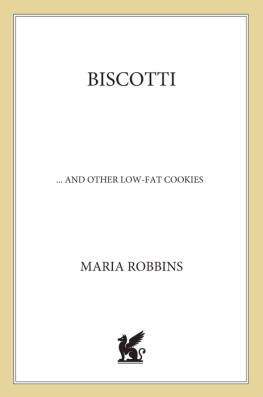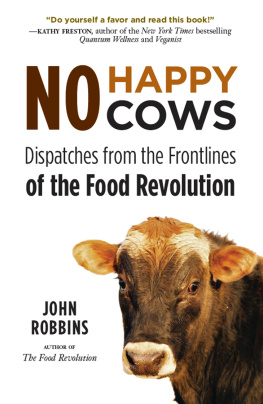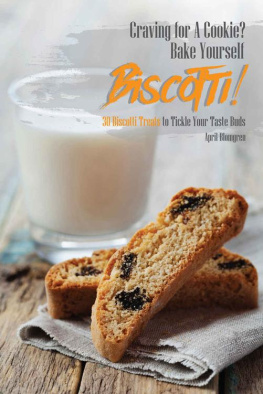Biscotti

and Other Low-Fat Cookies

Maria Robbins
Illustrations by Durell Godfrey

St. Martins Griffin  New York
New York
FOR KEN
The author and publisher have provided this e-book to you for your personal use only. You may not make this e-book publicly available in any way. Copyright infringement is against the law. If you believe the copy of this e-book you are reading infringes on the authors copyright, please notify the publisher at: http://us.macmillanusa.com/piracy.
WHY BISCOTTI?

I sampled my first biscotti after dinner with my husband in a small, newly opened restaurant some fifteen years ago. It was not in Italy, but as far as we were concerned it was almost as good. We live 100 miles outside New York City in a small resort town by the ocean. It was and continues to be a wonderful place to live, but at that time the one thing we missed were the kind of restaurants that were available only in Manhattan. The new restaurant we tried that early spring evening was a revelation. The fresh, lovely flavors of Tuscany were to be sampled right here in our small town. When the meal ended we were brought a plate of biscotti di Prato, the pale gold biscotti studded with almonds that we all know today. In the middle of the plate was a glass filled with amber-colored wine. We dunked the biscotti into the Vin Santo and marveled at the fabulous tastes and textures. I was hooked. After we had eaten all the cookies on our plate, I begged the waiter to let me have some more to take home. The following morning I dunked biscotti into my morning coffee, and I remembered the rectangular boxes of zwieback my mother used to buy, and how I dipped these hard, slightly sweet cookies into hot cocoa in the winter and into a cold glass of milk on summer mornings. I remembered the hard, raisin-studded sukhariki (see recipe ) my aunt used to bake and how I loved to dunk them into a cup of hot chamomile tea. The biscotti di Prato, which had been a new discovery the previous evening, turned out to be part of a thread that reached back into my childhood. We became regulars at the restaurant, dining there as often as our budget and our conscience allowed. Our meals always ended the same waybiscotti and Vin Santoand I always took some home with me. After a while the owners packaged the biscotti and sold them in clear cellophane bags. At last, I had a steady supply and I was happy. It never occurred to me at the time that I could make my own biscotti, and many years went by before I came to my senses.
Biscotti, the word, means twice baked, from the Latin words bis, meaning twice, and coctus, past participle of coquere, to cook. Today in Italy the word biscotti is used to mean cookies in general, but in this book I use it to refer to the cookies that are indeed twice baked, once when the dough has been shaped into a log about 14 inches long, and again when the log has been sliced on the diagonal into -inch-thick cookies that are baked again until they are dry and crisp. This second baking is what turns a soft cake-like cookie into a crunchy biscuit that will keep for a long time. Almost every European culture has a version of this kind of cookie. There are German zwieback, English rusks, Russian sukhariki, Jewish mandelbrot, and French biscotte. Many of these hard, dry cookies were developed for their keeping qualities and associated with sailors and their long voyages.
When I started baking my own biscotti, I learned that the cleanest, brightest flavors are typical of the biscotti with the lowest fat content. These biscotti also have the longest shelf life, sometimes actually improving with the passage of time. The addition of butter or oil not only made the biscotti more tender so that they resembled cookies, but they didnt keep as long and they were totally unsuitable for dunking. One dunk and you were left with soggy crumbs. The recipe for biscotti di Prato became the model for most of my other recipes in the book.
The biscotti in this book are mostly low in fat, and are hard and dry, waiting to be dunked into your favorite beverage. They are cookies for grown-ups, to be savored with a glass of wine, a steaming mug of cappuccino, or a relaxing cup of tea. The fact that they are low in fat and relatively low in calories (about 45 calories per biscotto) makes them ideal small indulgences in todays fat-conscious, calorie-counting world. They are very easy to make and taste better than overpriced commercial biscotti.
Besides biscotti, there are recipes for delicious meringue cookies, which have no fat and fewer calories (15 to 20 calories per cookie), and a handful of other low-fat cookies to round out the kinds of treats that are good to have on hand.
There are no ersatz ingredients in these recipesno fake fat, no prune butter substitutes for chocolate. These are classic cookies that happen to fit perfectly into todays light way of eating.
INGREDIENTS

The important thing to remember whenever you are cutting back on fat in any recipe is that you must compensate with flavor. You will always get the best flavor from fresh, pure ingredients. You will probably be able to find most of the ingredients called for in a well-stocked supermarket or health food store. But I have also provided a list of reliable mail order sources. Remember, shopping for the best ingredients is as much a part of the cooking process as turning on the oven.
Flour

Unbleached all-purpose flour is called for in the great majority of these recipes. If you are only an occasional baker and tend to keep flour around for a long time, be sure to smell your flour before you use it. If it has an off smell, it has probably started to turn rancid and should be replaced. Store flour in a cool place in an airtight container. Measure flour by spooning it lightly into a measuring cup until it overflows, then level the top with the edge of a metal spatula or a knife. Do not tap the measuring cup to make the flour settle or try to press it in. Your measurement will not be accurate.



















 New York
New York
